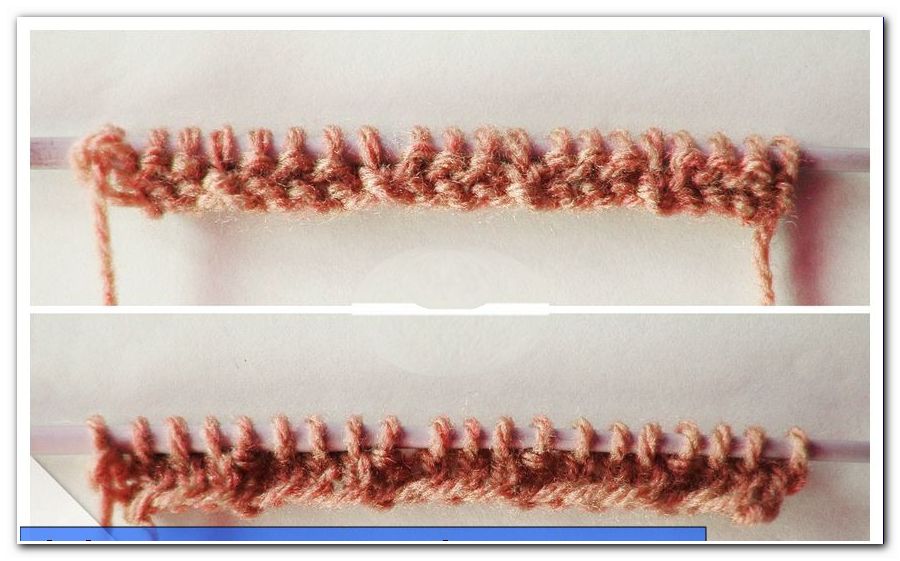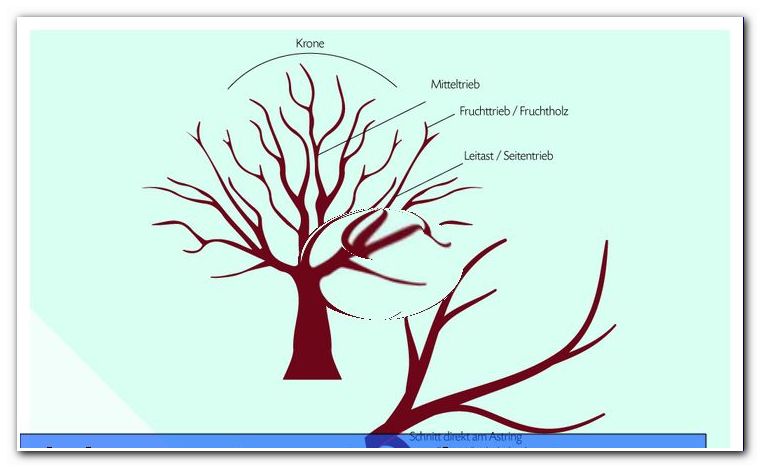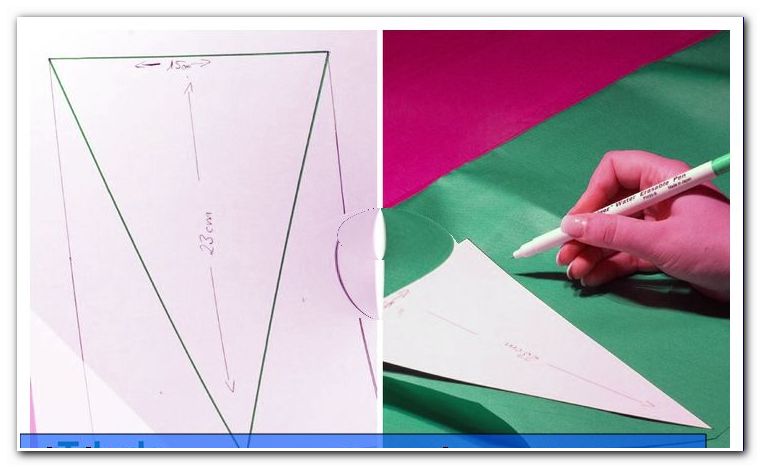Installing cabinet doors - simply set the furniture hinges

- The types of hinges
- concealed hinges
- Stollen hinges
- Inlet hinges
- Aufschraubscharniere
- Glass Door Hinges
- The mounting of the hinges
- The correct adjustment of the hinges
- Adjust the height
- Adjust the depth
- Adjusting the slope
- short version
- The correct adjustment of the special hinges
Cabinet doors are one of the most striking things in the home, as they not only protect objects from dust, but are also an expression of the living atmosphere. Set badly, this can be disturbed quickly, because you can see from afar, because of the straight forms of most furniture, if a closet door hangs askew.
Door hinges are an indispensable addition to any cabinet, whether glass doors, wooden doors or other materials. Incorrectly adjusted, tilted hanging doors not only look extremely ugly, they also damage the cabinet and the doors themselves. Too low-hanging doors drag over the bottom plate of the cabinet or the floor of the room. What works for a short time without problems, can be a claim in just a few weeks. How to prevent this explains this manual.
In order to prevent crooked hanging doors and thus to avoid warping of the cabinet or scratches, a correct adjustment of the hinges is unavoidable. However, to do this, it is first necessary to clarify which hinge is involved. There are many hinges on the market and depending on the design different settings are possible. This means you can not change the height, depth and angle of inclination of each hinge, and each hinge has its advantages and disadvantages.
The types of hinges
concealed hinges
Concealed hinges are probably the most common hinges and the standard hinges par excellence. Whether in living room cabinets, bathroom cabinets or kitchen cabinets, they are found in different shapes and types. Their big advantage is the very compact design and the high load capacity . Concealed hinges are available in a built-in version, while the cabinet door is located between the two side panels of the cabinet or as a stem variant. Here, the cabinet door conceals both side parts, sometimes the bottom and cover plate.

The opening angle can be up to 180 °, depending on the installation variant. These hinges are fitted with a 35 mm pot diameter by installing the hinge and fixing it with two screws. A mounting plate on the cabinet body forms the counterpart. The connection between both sides is the support arm. Screws on the mounting plate of the cabinet plate can thereby influence the furniture door in the inclination, the depth and the height.
Stollen hinges
Stud hinges are a special type of cup hinges. These hinges are particularly suitable for tight installation options due to their short and compact design. The space requirement on the cabinet sidewall is often only 28 mm in depth. Disadvantage of this type of hinge is a maximum opening angle of 95 °, in addition, in contrast to normal concealed hinges low load capacity, so doors must be small and light.
Inlet hinges
A special type of cabinet hinges form the inlet hinges. These are cylindrically shaped on both sides of the hinge and can thus be embedded in either the side wall or the cabinet door. Alternatively, inlet hinges can also be mounted in the end faces of the side wall and cabinet door. The big advantage is that these types of hinges are hardly or not at all when closed or opened. Disadvantage, however, is the low load capacity of the hinge. In addition, cabinet door, as well as the body must have a high material thickness. Also a big disadvantage is that a height adjustment of the door is not possible. Also often missing other adjustment options of the door.
Aufschraubscharniere
Screw-on hinges are a variation of the concealed hinges. They have the same features as concealed hinges but, as the name implies, are only screwed to the side wall of the cabinet and door. The additional countersinking, the so-called pot in cup hinges, in which the joint disappears when closing the door, is omitted in the screw-on hinge. Disadvantage is the larger space consumption of the hinge.
Glass Door Hinges
Glass hinges are a very special form of hinges, they can be used as a cup hinges but also as Aufschraubscharnier. The holder of the glass side is always the same. The glass has pre-drilled erasers through which the screw and a plastic core are guided for fastening. The insides of the glass side mount are usually either plastic or some other soft material that is designed to hold the glass door, but to protect it from excessive pressure.
The mounting of the hinges
Hinge assembly is best explained by the example of a cup hinge, as this has the most adjustment options. The cabinet door can be changed in height, depth and inclination angle up to - / + 2 mm. For purchased furniture, all holes and screws on the door and body already exist.
Step 1
As a first step, all pot bands are mounted on the door of the cabinet. For this purpose, the pot is pressed into the associated, standard 35 mm bore. The arm of the cabinet door points outwards. Above and below the pot bore are two more holes, these are used for the screws of the pot bands. The pot straps are fixed with the appropriate enclosed screws.

step 2
The second step is to mount the mounting plates to the inside of the cabinet. Which side of the mounting plates must point to the front, is usually marked as an arrow on the mounting plate. The arrow must always point outwards. The mounting plate can now be fastened to the cabinet body with the appropriate screws. It is important that the mounting plates have a slot, so that they are both up and down sliding. For the first assembly, the plates are screwed in the middle.

step 3
Once this work step has been completed, the cabinet door can be hung for the first time. First you hang the cupboard door at the top and finally at the bottom. In principle, especially with large doors, it is advisable to ask a second person for help, who holds the door while fixing the door to the carcass.

Step 4
The door can now be closed for the first time and the overall picture controlled. You close the door carefully and without violence.
Tip: If the door of the cabinet is not down to the floor, even thicker shoes can be put on and the wardrobe door can be put on top of it. Something can be conveyed with the foot to help mount the cabinet door when no second person can help.
The correct adjustment of the hinges
Adjust the height
Once the cupboard door is firmly fastened to the cabinet, it is first time to adjust the height. It should be set first, since this setting is the starting point of all other settings. With eye or inch rule, the distance between the upper edge of the door and the lower edge of the cabinet lid is now controlled. Subsequently, the distance lower edge of the door to the upper edge of the cabinet bottom is measured. If the distance is the same, this is excellent, if not, now has to be checked. For this purpose, the cabinet door is removed again. It is done in reverse order as when hanging.
Important: Never change the height when the door is mounted, the screw holes can be frayed by the weight of the door.

The readjustment takes place on the bands on the inside of the body. Above and below the suspension of the support arms, the screws are now easily released. If the door is too low, all hinges must be set slightly higher. If the door is too high, the hinges have to be lowered a bit. When all the bands have been moved, the screws are tightened again and the door is hung again. If the distance up and down is now the same, the next setting can be started; if not, the last step must be repeated again. The important thing is always the tightness of the screws.
Adjust the depth
If the height of the cabinet is correct, the depth of the door is set. If you look at the cupboard from the side, on the side where the hinges are sitting, there must be a distance of approx. 1 - 2 mm between the body and the door. The door is opened and the gap is observed. At no time may the door grind on the carcass. Should there be any contact between the two parts, the door will be opened. The support arm has two screws that run in a horizontal direction . The front screw is uninteresting at first.

Important is the rear screw, which also attaches the door to the cabinet. If the door grinds on the carcass, the screw must be loosened and the cabinet door pressed in or out a little. It is important that the gap of 1 - 2 mm runs from top to bottom.
Adjusting the slope
The last shot is that of the slope. If you look at the cabinet with the door closed from the front, there is a horizontal gap between the cabinet door and the bottom of the cabinet as well as the cabinet lid both above and below the cabinet door. Due to the squareness of the door both columns are identical. If the gap is even, the work on the cabinet door would be finished, if not, must be readjusted.
To do this, the last screw on the hinges is used, the one that should just be overlooked and sits on the mounting bracket at the front. This screw has a double function . On the one hand, it serves for the angle of inclination, on the other hand, to move the entire door horizontally.
Let's start with the angle of inclination . If the door with the upper right corner (assuming that the hinges are fastened on the left side) is facing upwards, the screw on the upper hinge must be screwed in a little, and the lower hinge must be screwed out a little bit.

Should the door with the right corner look downwards (provided that the hinges are fastened on the left side), the lower screw must be screwed in, the upper screw must be unscrewed. This will now be done until a uniform gap is created.
If there are two cabinet doors or if the door on one side looks a bit over the cabinet body, these two screws are also used. If the door (provided that the hinges are fastened on the left side) is on the right-hand side beyond the body, both screws must be removed a little bit more evenly. The cupboard door moves to the left. If there are two doors facing each other and if the middle gap is too big or too small, the hinges on both the left and the right door will be readjusted evenly on all hinges.
short version
Door hinge / hinge left:
- When the screw is turned in (clockwise), the door moves to the right.
- When the screw is turned out (counterclockwise), the door moves to the left.
Door hinge / hinge right
- When the screw is turned in (clockwise), the door moves to the left.
- When the screw is turned out (counterclockwise), the door moves to the right.
When all operations have been completed, the door is set up correctly. Cabinets with more than two hinges always use the top and bottom hinges for adjustment. For all other hinges, the screws are left loose to accommodate the other hinges. Once the cabinet is aligned, the screws of these hinges are tightened.
The correct adjustment of the special hinges
Other listed hinges such as cleat hinges are not different in the assembly instructions. Also, glass hinges are treated as well, but important here is the mounting of the bands on the glass side. Not to forget here are the always supplied plastic body, which belong in the holes of the glass door and through which the screw is passed. Great care is required here when tightening the screw. Slightly hand-tight, the screw should not be tightened, otherwise a glass breakage may occur.
Tip: Put one to two drops of threadlocker on the screw and wait a few minutes. The varnish sticks to the threads and thus prevents an independent loosening of the screws. If a hand is put on the screw again with a screwdriver, the paint breaks and the screw can be loosened easily.
Screw-on hinges can also be set using the same options, except that the adjusting screws are located at a different point than the concealed hinge, depending on the manufacturer.
There are differences however with the inlet hinge, these can be corrected in most cases neither in height, inclination and depth. The correct seat is specified by the manufacturer.
Tips for quick readers
- Hang the door first in the hinge, last in the bottom
- when removing the door reverse order
- first adjust the height of the door, then depth, then bevel
- Do not leave the door mounted when adjusting the altitude
- Distance lower edge of door - base plate min. 1 - 2 mm
- If there are several hinges, use the top and bottom hinges to align, all other screws on other hinges are left loose and tightened after alignment




